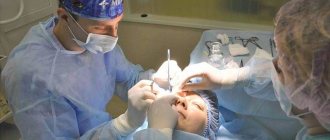We will tell you about anesthesia and who the anesthesiologist is and what he will do during the test or surgery.
You come to the clinic for an annual medical examination or with any other problem. During the medical examination, you needed to perform a diagnostic test (gastroscopy, colonoscopy, etc.) or surgery. Your doctor recommends that you perform the test or surgery under anesthesia.
Agreeing with the recommendation of the attending physician, you anticipate the upcoming operation or examination with excitement and fear. Very often the patient is more afraid of the upcoming anesthesia than the operation itself. Your fear is especially strong if this is your first anesthesia.
Who is an anesthesiologist?
Anesthesiology is a branch of medicine that studies means and methods of providing anesthesia (that is, loss of sensitivity, including pain) for various acute pain syndromes, shock conditions, injuries, and surgical interventions. An anesthesiologist is a specialist who specializes in anesthesiology. This is one of the most erudite and responsible professions of all existing medical specialties. The anesthesiologist has first-class knowledge in all fundamental areas of medicine. He knows how the entire body works as a whole and each of its functional systems, each internal organ, each cell of the body.
As soon as this medical specialty appeared, it immediately became possible to perform surgical interventions without pain, stress and severe, life-threatening complications. The anesthesiologist is equipped with all the knowledge and modern technical capabilities necessary to minimize the risk of fatal complications during the surgeon's operation.
The work of an anesthesiologist is not only about competent and effective pain relief. His work begins even before the operation, with a study of the patient’s medical history and a personal conversation with him. From the patient he learns about his chronic and previous diseases, operations using anesthesia, allergic reactions to medications or food. Taking this information into account, a preliminary analysis of the functioning of the heart, lungs, blood vessels, kidneys and liver is carried out, tests and additional studies are prescribed. All this is necessary for the correct administration of anesthesia during surgery and minimizing the development of possible risks to the patient’s life. Only an anesthesiologist determines the optimal type of anesthesia.
Before an operation or examination, he conducts a calming conversation with the patient. Its meaning is a friendly explanation of the procedure for using anesthesia and neutralizing the fear of surgery. The doctor tells the patient how to properly prepare for the upcoming anesthesia and surgery. It is important that, as a result of such contact, the patient and his family do not feel nervous and are confident in the professionalism of the anesthesiologist.
Modern anesthesia is safe
Head of the department, anesthesiologist-resuscitator at the Pasman Clinic Alexey Butich talks about proper anesthesia and methods for quick recovery after operations.
A person is afraid not so much of the surgeon and the scalpel as of anesthesia and its consequences. How do you cope with such preoperative fears?
Indeed, sometimes we encounter patients who have had negative experiences with anesthesia in the past. To dispel unfounded fears, we tell such patients about modern anesthesia technologies. Both the anesthesia itself and recovery from anesthesia have today become much more comfortable and safe for the patient.
The medicinal and psychological methods that we use immediately before the operation set the patient up for positivity, and in the operating room he calmly goes to sleep even before the surgeon arrives.
A person also wakes up calmly—without fears or anxieties. Sometimes we can even “program” pleasant dreams.
Pleasant, comfortable and safe?
A glass of champagne is more dangerous. We work with propofol and sevoran - these drugs are among the safest today.
There is a concept of using a target dose of anesthesia. The goal is to achieve adequate sleep induction and adequate pain relief. To do this, we use infusion pumps or, as they are commonly called in Russia, infusion pumps.
How propofol works if it is administered manually: the concentration of the substance in the body reaches a peak point and after 15 seconds begins to decline, because the drug is quickly destroyed. Then enter again - you get this jagged graph. If the next infusion exceeds the peak point limit, it means that the substance has not only reached its intended destination, its excess has penetrated into the heart and kidneys.
When the drug is gently administered using infusion pumps, the amount of propofol in the body is kept at the same level and does not cross the dangerous line. In this case, the drug acts only on what it should - on the gamma-aminobutyric acid receptors of the brain. That is, a person receives safe anesthesia.
Do you improvise during operations?
There are standard algorithms for administering anesthesia. We are obliged to comply with them. But at the same time, an experienced anesthesiologist always “feels” the patient, understands his individual characteristics and corrects the nuances during anesthesia. This is the art of an anesthesiologist.
How to endure the pain that comes after even the most comfortable anesthesia?
Let's clarify what pain is. This is a signal that is sent to the brain when something is wrong in the body. If after surgery we feed the patient with strong painkillers, we will practically suppress the body’s natural signaling system about problems and threats. This means that the body will not turn on internal resources, protective forces formed in the process of evolution. For what? He already feels good, comfortable, and doesn’t hurt.
In this situation, the patient is eliminated from the fight for his speedy recovery, leaving this task to the doctor.
Giving the patient the opportunity to mobilize the body's resources is one of the provisions of the fast rehabilitation technique - “fast track”, which we use during intensive therapy.
In order for the wound to heal faster, you need a building material - protein. In world practice, nutritious protein shakes are used for this. By receiving them on the first or second day after surgery, a person recovers much faster. By the way, in our clinic, operated patients always receive such cocktails; this is included in the rehabilitation program.
To speed up healing, we do not allow a person to “stagnate.” Movement is life. In motion, blood circulation is more active, metabolic processes in the body occur faster, which means that all unnecessary substances are utilized and removed from it faster, cell regeneration occurs faster, and wounds heal faster.
So we have our own little secrets, thanks to which a person gets up quickly enough and experiences pleasure from it - even if it hurts, even if it’s a little “stormy,” but he is strong, he feels like a young man, he takes the first step towards recovery.
Is it the same with children?
With children it’s even simpler - they live according to the model: “I walk - I’m healthy.” After some simple operations, if the child’s condition allows, I take him off the operating table, put him on his feet, and together we walk down the corridor to his parents. Parents calm down, the attitude “everything is fine” is in progress.
And this significantly helps recovery.
Quite complex operations are performed at the Pasman Clinic. Does it happen that you have to refuse patients?
We take a person for surgery when we are sure that in his current condition the person will tolerate it normally. In other cases, we recommend a good therapist. A person is treated for two or three months, he is “pulled up” to an operable state, and then we successfully operate on him.
The operation may proceed without complications, and physically the patient will recover quickly, but psychologically it will be difficult for him, for example, because an organ was removed. How then to nurse? In a word?
The word of a doctor, the word of a person who is trusted, is of great importance.
When you are left alone with a patient, you understand how important it is to convey to him the belief that everything will definitely be fine. Of course, when an organ is removed, it is very difficult for a person. It's clear. But life still goes on, you can’t give up. In addition, a person is not just a set of organs, it is a single system, and after some time the body adapts to its new state and in some way learns to compensate for the loss. It is important not to lose hope. Share:
General anesthesia
General anesthesia (narcosis) is an artificially induced reversible state of inhibition of the central nervous system, which causes loss of consciousness and memory, relaxation of skeletal muscles, reduction or shutdown of some reflexes, and loss of pain sensitivity (general anesthesia occurs). All this occurs when one or more medications (anesthetics) are administered, the optimal dose and combination of which is selected by the anesthesiologist, taking into account the individual characteristics of a particular patient and depending on the type of medical procedure.
General anesthesia, in its importance, represents the main section of that long chain called anesthesiological support for surgical intervention.
Typically, general anesthesia is initiated and maintained by giving the patient intravenous drugs, which are administered through a venous catheter (“intravenous anesthesia”), inhalation drugs, where a special gas is inhaled by the patient through a breathing apparatus (“endotracheal anesthesia”, “inhalation anesthesia”), or their combination.
The depth of general anesthesia (anesthesia) is modified by changing the administered dose of anesthetics depending on the stage of anesthesia and surgery, as well as the general condition of the patient. Thus, more traumatic and painful stages of surgery require a greater depth of anesthesia. At the end of the operation, the anesthesiologist completely stops the supply of drugs, the concentration of anesthetics in the brain begins to continuously decrease, after which the process of returning consciousness occurs until it is completely restored.
Necessary risks
It is impossible to carry out a complex operation without the use of general anesthesia, since without it the patient will not withstand the painful shock. Recovery from anesthesia may be required if its use has caused a negative effect on the body:
- Depression of consciousness and respiratory functions
- Blood pressure surges
- Arrhythmias
- Chills
- Nausea
The state after anesthesia is especially unstable after neurosurgical operations Neurosurgical operations
Emergency or planned surgical interventions in the functioning of the brain and spinal cord are carried out with the aim of correcting or eliminating a pathological condition.
Sedation
Sedation is a “dream-like” state of peace, calm and equanimity that is induced by a relatively small dose of drugs typically used to administer general anesthesia.
Sedation allows the patient to relax physically and emotionally during any medical examination or procedure that may be unpleasant or painful (for example, indications for sedation may include endoscopic examinations, biopsies, radiological studies, dental treatment, etc.).
The state of sedation, on the one hand, creates good conditions for the surgeon’s work, since the patient, being half asleep, is quite relaxed. On the other hand, sedation in its depth is a relatively superficial state, so that if necessary, the patient is able to follow the instructions of the operating surgeon at any time, which is, of course, very important.
Sleep during sedation is not very deep, so the patient’s breathing function, unlike general anesthesia, is usually not impaired. After sedation, the patient will either remember nothing at all about the procedure performed, or have very little memory of the past.
Technically, sedation can be performed both in the operating room and outside of it. Despite this apparent simplicity, sedation requires a very careful and scrupulous approach - the same as other types of anesthesia.
"Semax 0.1%" helps:
- Accelerate recovery from anesthesia and the state of postoperative disorientation;
- Restore normal metabolism Metabolism Metabolism
, which allows the body to maintain vital functions, maintain its structures and respond to environmental influences. and functioning of brain cells; - Prevent dysfunction of the respiratory, cardiovascular, digestive and excretory systems;
- Reduce the intensity of pain;
- Normalize the work of vegetative centers.
Nerve plexus block
Nerve plexus block (conductor block, nerve block, peripheral anesthesia, nerve block) is one of the methods of regional anesthesia, in which an anesthetic is injected in close proximity to the peripheral nerves. A technically complex method that does not always provide complete anesthesia of the surgical area. But nowadays, anesthesiologists use not only their own knowledge of anatomy, but also ultrasound machines and neurostimulators to accurately determine the location of the desired nerve. Most often, the method is used for operations on the upper and lower extremities, often in combination with intravenous sedation.
{tab General anesthesia}
Possible consequences for the child after general anesthesia
Exit from the sleep state largely depends on the level of health of the children, the type of anesthesia used and the specific drugs. The average time for full restoration of consciousness is from 1 to 2 hours, the return of cognitive functions is 1–2 days. During this period, the child is under constant medical supervision.
Modern anesthetics are quite safe, and serious negative consequences after anesthesia in children are rare. The most common problems are:
- nausea and vomiting;
- dizziness;
- mild disorientation;
- headache and muscle pain.
With the correct selection of techniques and drugs for anesthesia, high-quality preoperative examination and highly qualified anesthesiologist, the risk of problems is minimal.
What to expect from anesthesia in the future
The main feature of modern anesthetics is good controllability. Once the supply of the drug is stopped, it begins to quickly disintegrate. As a result, it is convenient for the doctor to control the time and depth of anesthesia for different conditions: the anesthesiologist will select one mixture of drugs for a patient with heart disease, and another for a person with respiratory tract disease. In both cases, it will be anesthesia with minimal drug load on the body. At the same time, various anesthesia devices, such as modern intravenous catheters, increase safety and comfort during surgery. Careful monitoring of the patient’s condition (measurement of pulse, blood pressure, amount of oxygen in the blood automatically) is another bonus of general anesthesia in modern conditions.
New generation local anesthetics have much fewer side effects and contraindications compared to drugs even ten years ago, and the waiting time for an effect has been reduced to five minutes. Doctors agree: over time, the percentage of allergic reactions will become zero, and the injection itself will be completely painless. The controllability of the process during anesthesia will also increase: it will become possible to bring a person in and out of a state of deep sleep even faster, as well as return him to consciousness at any appropriate moment. Oleg Karmanov does not rule out that in the near future, instead of intravenous anesthesia, a drug in the form of a pill will appear: he ate the pill and fell asleep.
True, anesthesiologists will still not be left idle: the patient’s condition is very important to constantly monitor and correct correctly. But whether it will be possible to replace anesthesia with hypnosis is a big question. In 2006, British television showed an operation to remove a stomach tumor under hypnosis, without the use of anesthesia, and in 2008, in one of the Iranian clinics, a hypnotized woman was successfully performed a caesarean section without anesthesia. However, Mikhail Popov notes that, despite the emerging information about such cases, there is no scientific research on this topic yet.
Photos: vitaly tiagunov - stock.adobe.com, Africa Studio - stock.adobe.com, arska n - stock.adobe.com
Types of anesthesia during operations
General anesthesia
With such anesthesia, consciousness is completely “switched off”, reflexes are suppressed, including breathing, and sensitivity is lost. It is carried out with tracheal intubation and artificial ventilation or by installing a laryngeal mask. The mask consists of soft and thin latex, it is placed on the pharynx without penetrating the larynx. An intubation tube is placed in the larynx and isolates breathing so that stomach contents do not enter the lungs.
Intravenous with spontaneous breathing
The patient is breathing on his own, but is unconscious. Used during long-term operations, it allows you to dose drugs, delivering them into the blood throughout the entire operation.
Epidural and spinal (regional)
It involves “switching off” the conductivity of a certain nerve or their plexus. The patient remains conscious. Additionally, a sleeping pill may be given so that the patient does not see the progress of the operation and does not experience stress because of it.
Local anesthesia
This type of pain relief is familiar to anyone who has visited the dentist. Involves eliminating sensitivity in a certain area.
The choice of type of anesthesia remains with the anesthesiologist. The specialist must take into account the type of operation, the condition of the patient’s body, his age and many other factors.










